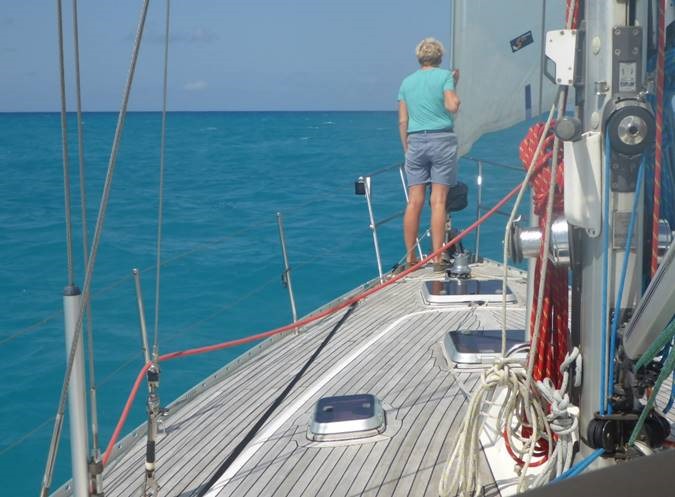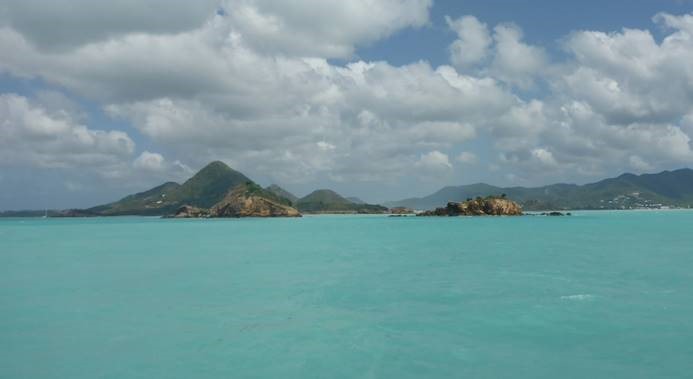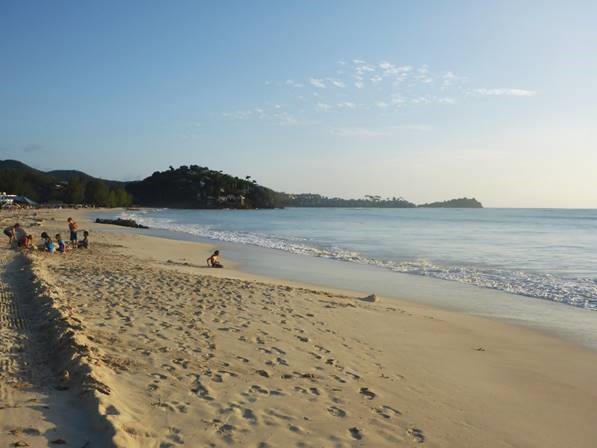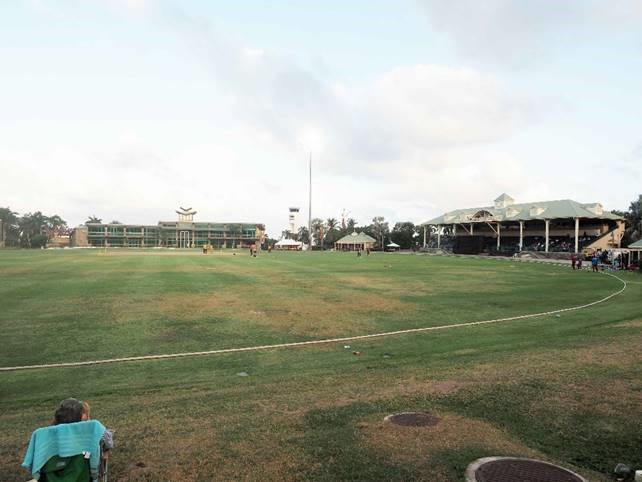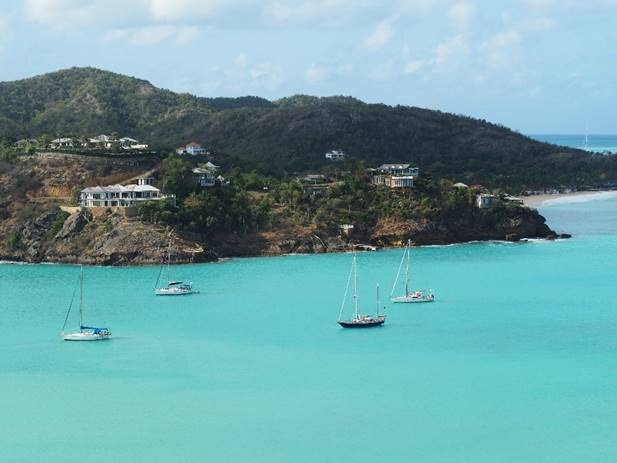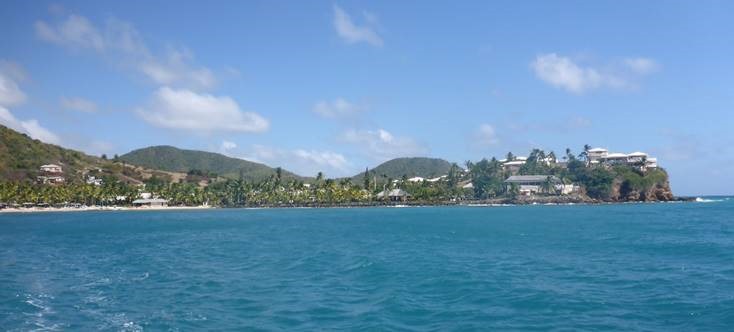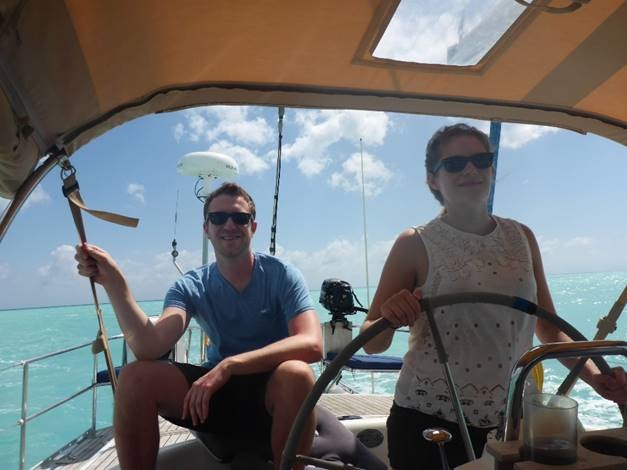13 March - Colour, cricket and chillin' in Antigua

|
17:00.8N 061:46.4W Despite the unusual disturbances, we decided to stay in Freeman Bay overnight. Nelson’s Dockyard in English Harbour looked quite full and we did not have the energy to move round the corner into Falmouth. By midnight, the wind had dropped and the boats began to circle round their anchors in unpredictable ways. We heard a gentle tap on the hull and realised that our American neighbours had bumped into us. As the last ones into the anchorage, we had to take avoiding action. We decided to set our kedge anchor and whilst digging it out of deep store, David the American offered us the use of his dinghy to deploy it. That was very useful as our dinghy was still rolled up on deck. For the second time on this deployment we used our extra long warp and half an hour later the yacht was effectively ‘moored’, with the second anchor laid out at roughly 150o from the main cable. This stopped us from swinging over such a wide arc and took us well away from the other boats whilst keeping us out of the main channel. A peaceful night ensued but in the morning we saw that we were quite close to an unlit navigation mark, so rather than leave the boat unattended whilst we went ashore to clear customs and explore, we got underway and headed west to Jolly Harbour, about 20 miles away and closer to where Anna and Matt were staying.
Watching for turtles, flying fish and coral reefs in a turquoise ink The sail round was a revelation: the shallow water was like a turquoise soup, scattered with the odd turtle and a fine reef system off the southern side of Antigua that takes the edge off the Atlantic swell. The shoreline is well endowed with sandy beaches and not over-developed – what houses there are looked expensive though, and the hotels suitably exclusive! The island is not as mountainous as those further south; I believe it is much older geologically. On this section of coastline, the vegetation is less dense than, say, Dominica or Martinique and large areas are either bare or under some form of economic development. Inland, there seemed to be buildings scattered everywhere. The bays around the southwest corner seemed less crowded with yachts than other islands.
The approach to Jolly Harbour Jolly Harbour is a cross between Port Solent and the Rodney Bay development in St Lucia. The entrance is shallow and well marked, with depths never much over 4m shoaling rapidly once you stray outside the dredged channel. It’s all quite tastefully done, but once inside the harbour it reminded me more of parts of Florida: residential waterfront with private docks, some with motor yachts on lifts that were bigger than Escapade! Most of the houses seemed quite small and many of the docks were empty. The Customs and Immigration people have their own dock at the head of the harbour, where we secured alongside. I filled out the same forms on a computer in the Customs office and then by hand in the Immigration and Port Authority offices – I suppose it provides a form of employment for someone? We were in touch with the dockmaster in the marina, so once formalities were complete we moved in to find our allocated berth. He turned out to be rather uncommunicative and we lined up to back into an upwind berth on the port side of a channel, only to be told at the last minute that our berth was on the downwind side. I aborted the approach as the channel was only a few feet wider than the overall length of the boat. After a couple of attempts which I bailed out of early (the 20 knot crosswind was quite a factor in this) I made a peach of an entry into our allocated slot. Mr Grumpy simply observed that I had taken rather a long time, but before we had a chance to debate the finer points of communications and boathandling he told us that there was no fresh water in the marina. We left, unable to see the point of an expensive alongside berth cheek by jowl with other people, stiflingly hot in the evenings, with no water to wash the boat off. We picked up one of their buoys in the outer harbour instead, at a fraction of the cost. Fortunately our water tanks were reasonably full so we got most of the salt off the important bits before going ashore to meet up with Anna and Matt. They joined us at a fine beach bar called Castaways to watch the sunset from the northern end of a glorious beach – part of the Jolly Harbour Resort but not overcrowded or tawdry in any way.
The beach at Castaways – one of a whole stack of wonderful stretches of sand around Antigua The following day we went to the Coolidge Cricket Ground near the airport to watch England Lions take on West Indies A in a fifty overs cricket match. The entry price of £5 a head got us seats in the shady grandstand between the two teams’ pavilions and with three beers for £3.50 it promised to be an enjoyable day out. West Indies batted first and whilst England Lions fielded well and bowled intelligently, Windies made a comfortable 256-8 in their allotted overs. England Lions started their reply at 6pm, just as the lights were coming on. They got off to a good start and for the first ten overs looked quite promising. But the Windies had some spin bowlers who wrapped the English in knots. Worse, they were unable to hit the ball into the gaps and seemed content to run singles at a walking pace, rather than look for a second run. No doubt they were petrified of being run out… England Lions is the ‘development’ side for people on the verge of the First XI, so perhaps they were more concerned to put on a good individual display to impress the selectors than turn in a strong team performance?
The batsmen plodded, then crawled. The required run rate rose alarmingly, but they seemed unable or unwilling to react. When batsmen were out, they returned to the pavilion where nobody said anything and the only eye contact seemed to be with the ground. One of the coaches, sporting a fabulous suntan, came and sat in the stand near us. I observed to him that they all seemed disinterested, but Julie shooed me off before we came to verbal blows. I counted ten coaches or camp followers of one form or other, all enjoying the sunshine and wondered whether they thought they were on a well-deserved holiday or a serious cricket tour. Needless to say, England Lions were bowled out well short of their target and lost the series. England Sheep would be a better name for the side. Windies A (despite dropping too many catches) played well and deserved to win.
The tea (beer and goat soup) interval at the Coolidge Ground. The main pavilion was built by the disgraced American financier, Charles Stamford. I wonder if he was watching on telly from his prison cell? On Saturday, whilst Julie and Anna returned the hire car (it was much cheaper to hire a car for a couple of days than take taxis anywhere and the buses have a poor reputation) Matt and I did some rubber boat training and qualified him as ‘Boat Boy First Class’. We then set off north to Deep Bay, just south of St John’s Harbour. It’s a beautiful spot, with a long empty beach at the head of the bay and a well-known wreck in the middle which is popular with divers and snorkelers. We jumped into the warm, turquoise bathwater and went to investigate. Unfortunately, the water was so soupy that you could not see your own hand at the end of your arm. So we explored the shoreline instead: some great beachcombing to be done here, although it is illegal to remove anything so we simply arranged a group of various exotic corals, seaweeds and shells in an arty pattern before realising that the camera was onboard Escapade… Julie and I climbed to Fort Barrington on the top of the hill between Deep Bay and St John’s Harbour, where the views were spectacular. Once again, there were only a handful of yachts anchored there.
Anchored in Deep Bay. Do not adjust your sets – this is the colour! Keen to find some decent snorkelling, we sailed on Sunday for the north of Antigua, the Boon Channel and the fabled anchorages off Long Island and Parham. We were greeted with the fine sight of the brand-new RFA TIDESURGE at anchor just offshore. One of the ships built in South Korea (on time and under budget, so legend has it) she looked really impressive. As we sailed north under well reefed sails, we decided that the passage eastwards along the north coast was going to be slow and uncomfortable, so we turned around and headed for the south coast instead. It was a fine sail: quite rough, especially as we reached the south west corner, but fast. We went outside the reef system that had looked so promising a couple of days earlier and anchored in Carlisle Bay. The turquoise waters were still glorious, but here you could see quite a bit further. Unfortunately the nearby reefs were not terribly interesting, so we resolved to celebrate Mother’s Day sundowners in the bar of the rather smart-looking resort and go out to the main reef the following day.
Mighty TIDESURGE, carrying fuel for counter-narcotics and hurricane relief stores The Carlisle Bay Resort is indeed exclusive: you need about £1500 for a night. Apparently it was really busy last week and next week, but not this week… It looked beautiful, if rather empty.
Morris Bay – a fine anchorage for snorkelling on Cades Reef So we moved a mile or so west on Monday morning and anchored in Morris Bay, where there is another exclusive hotel, only with more patrons. We kitted out the rubber boat for an open ocean voyage and set off along the shore initially, then out across the Cades Channel. The beach along the shoreline here looks lovely and is well protected by an inshore reef at the western end. Offshore, Middle Reef marks the inshore limit of the reef, with Cades Reef providing the main barrier to the Atlantic swell. The passage out was rough, but we shipped very little water and the dinghy seemed quite happy. We anchored in about 3m of fantastically clear water and I waited in the boat for a few minutes whilst the others went off snorkelling. They reported a fine reef with good visibility and plenty of small fish. Julie and I swapped (we did not want the rubber boat to take flight to Venezuela!); I thought it had a better variety of coral than Tobago Cays, but not as many fish.
The new crew settling in to the Caribbean rhythm After lunch, we weighed anchor and motored into Falmouth Harbour. Like it’s Cornish antecedent, it is a magnificent natural harbour and is infact a UNESCO World Heritage Site. We picked up a mooring buoy off the Antigua Yacht Club and enjoyed gawping at a fine array of Classic Sailing Superyachts, the high tech racing machines used by their owners for fun, and an interesting collection of motor vessels ranging from a 1930s design that might have been a Royal Yacht to something painted grey with a number on the side, all modern and clearly owned by someone who wished he’d joined some tinpot Navy instead of becoming a billionaire.
|
